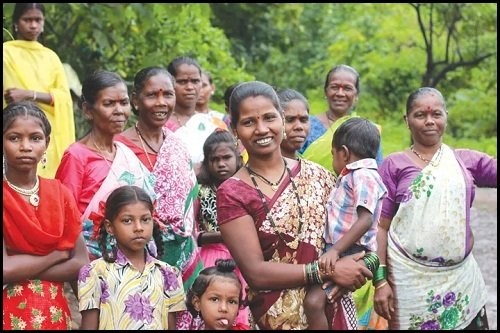Katkari Tribe | Van Dhan for Jaan and Jahaan
Key Takeaways
- The Katkari are an Indian Tribe mostly belonging to the state of Maharashtra. They have been categorised as a Scheduled tribe.
- The Census of India 2001 (GOI 2012) indicates that Maharashtra is home to 235,022 Katkari, mainly in Raigad and Thane districts.
- In Maharashtra the Katkari have been designated a Particularly vulnerable tribal group (PVTG).
Context: There are certain tribal communities who use a pre-agricultural level of technology, face stagnant or declining population growth, Katkari Tribe is one of those PVTGs and are using Giloy, used as a medicine, to ramp up local markets with the help of Pradhan Mantri Van Dhan Yojana.
What is Giloy?
Tinospora cordifolia, which is known by the common names heart-leaved moonseed, guduchi, and giloy (गुडूची) in Ayurveda, is used in medicines which treat various kinds of fever (viral fever, malaria, etc.) as well as diabetes. It is used in extract form, powder form or cream.
- It is indigenous to the tropical areas of Bangladesh, India, Myanmar, and Sri Lanka.
What you need to know about Katkari Tribe?
- The Katkari are an Indian Tribe mostly belonging to the state of Maharashtra. They have been categorised as a Scheduled tribe.
- They are bilingual, speaking the Katkari language, a dialect of the Marathi-Konkani languages, with each other; they speak Marathi with the Marathi speakers, who are a majority in the populace where they live.
- In Maharashtra the Katkari have been designated a Particularly vulnerable tribal group (PVTG), along with two other groups included in this sub-category: the Madia Gond and the Kolam.
- The Census of India 2001 (GOI 2012) indicates that Maharashtra is home to 235,022 Katkari, mainly in Raigad and Thane districts.
- Small numbers of Katkari also live the states of Gujarat, Karnataka and Rajasthan.
- The food habits of the Katkari are a reason for their social exclusion. The Katkari are one of only a few tribal groups in India that eat rodents, including the Little Indian Field Mouse, the Black Rat and the Greater or Indian Bandicoot.
- They believe that their strength and long life comes from eating the meat of rodents
What are Particularly Vulnerable Tribal Groups (PVTGs)?
Particularly vulnerable tribal group (PVTG) is a government of India classification created with the purpose of enabling improvement in the conditions of certain communities with particularly low development indices.
- During the 4th Five Year Plan a sub-category was created within Scheduled Tribes to identify groups that considered to be at a lower level of development.
- This was created based on the Dhebar Commission report and other studies.
- This sub-category was named “Primitive tribal group”.
The main features of such a group include the following and the groups that satisfied any one of the criterion were considered as PTG.
- A pre-agricultural system of existence, i.e., practice of hunting and gathering.
- Zero or negative population growth.
- Extremely low level of literacy in comparison with other tribal groups.
At the conclusion of the Fifth Five year plan, 52 communities were identified as being a “primitive tribal group”, these communities were identified on the basis of recommendations made by the respective state governments.
At the conclusion of the Sixth Five year plan 20 groups were added and 2 more in the Seventh Five year plan, one more group was added in the eighth five-year plan, making a total 75 groups were identified as PTG.
- The 75th group recognised as PTG were the Maram in Manipur in 1993-94.
- No new group was declared as PTG on the basis of the 2001 census.
- In 2006 the government of India proposed to rename “Primitive tribal group” as Primitive and vulnerable tribal group”
- PTG has since been renamed Primitive and vulnerable tribal group by the government of India.
- As per 2001 Census, Madhya Pradesh has the highest number of PVTGs in the country followed by Odisha, Maharashtra and Tamil Nadu.
- Andaman & Nicobar Islands has the lowest number of PVTGs in Indi
